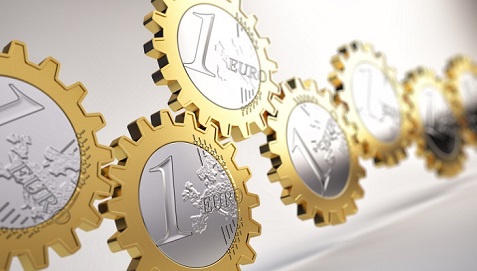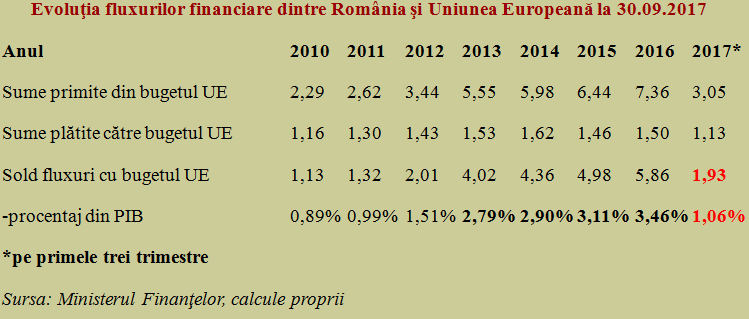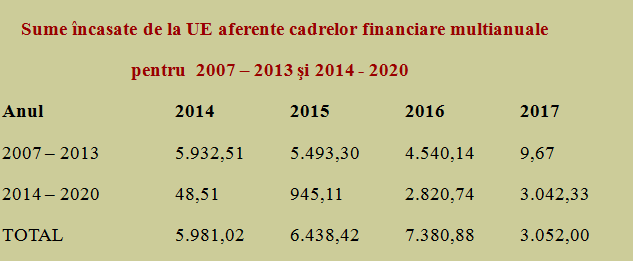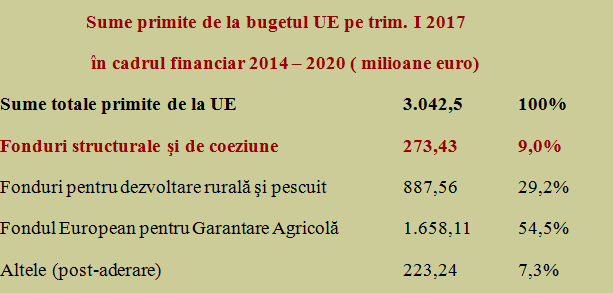 According to data released by the Ministry of Finance, Romania received only EUR 3.05 billion in the first three quarters of 2017, of which EUR 3.04 billion for the 2014-2020 financial framework and the remaining EUR 9.67 million are arrears from the 2007-2013 financial framework.
According to data released by the Ministry of Finance, Romania received only EUR 3.05 billion in the first three quarters of 2017, of which EUR 3.04 billion for the 2014-2020 financial framework and the remaining EUR 9.67 million are arrears from the 2007-2013 financial framework.
The amount is much lower than last year’s level, 41% if reported to the amount of EUR 7.36 billion recorded in 2016.
Obviously, it is impossible to recover the difference of 59% in the last quarter of the year, which will deprive the public budget of about three billion euros of European money (if we extrapolate the amounts received so far).
It is by far the main problem of budget execution in 2017, where the planned deficit is 2.96% of GDP or EUR 5.38 billion at the currently estimated GDP.
The European money could have come for free but for clear development projects, drafted according to the European norms and co-financed by the state budget.
Collecting this money, even at the 2016 level of EUR 7.4 billion (otherwise criticized at that time), would have even allowed for the budget outturn to meet the famous MTO (mid-term objective or financial stability mid-term objective of -1% of GDP assumed by Romania).
*
- Evolution of financial flows between Romania and EU at 30.09.2017
- Year
- Amounts received from the EU budget
- Amounts paid to the EU budget
- Flow balance with the EU budget
- – share of GDP
- * first three quarters
*
For received and paid amounts, we have the amounts showed separately in the two EU financial periods, 2007 – 2013 and 2014 – 2020 respectively. The balance, in terms of importance for the Romanian economy, resulted from the difference between the total collected money and the paid money related to the GDP that Romania obtained since 2010.
Looking back, we can see that the public finances’ dependence on the amounts received from the EU budget has rapidly increased. A significant leap took place in 2013, in 2015 and 2016, the EU money accounted for more than three percent of the national GDP.
In 2017, the „connection” to the 2014-2020 budget period has been made too slowly to compensate the inherent fall in the funds allocated in the previous period, 2007 – 2013, once the important resource resulted from the payment rule of N + 2 / N + 3 years after the extended payment expired ended abruptly.
*
- Amounts received from the EU corresponding to the multiannual financial frameworks for 2007-2013 and 2014-2020
- Year
*
The embarrassing start from 2014-2015 was concealed in 2016 precisely by the delay in how we moved until 2013. Prioritizing the absorption of the European funds as a matter of extreme urgency should have been natural in 2017 but this did not happen, whereupon the collapse of the money balance with the EU budget.
Practically (with the excuse, otherwise valid, that we are not to blame but to „difficult legacy” and in an electoral/post-electoral period, with its specific requirements), the tactics of risky income allocations has been chosen, with short-term benefits instead of a strategic organisation of the country development in the long run, which would have involved moderation and sustainability.
We consumed money that could have brought us European funds
Instead of moving quickly to put money out of our budget to amplify the effect of the European funds about 7 times (usually the national contribution is 15%) and develop faster the infrastructure, with roads, schools, hospitals and other similar things necessary in a civilized country, we sent our money to consumption.
Even the amounts received rather came automatically, through the already allocated amounts of the European Agricultural Guarantee Fund, which represented most of the money inflow to the country.
Unfortunately, the monumental counter-performance officially registered is not a central topic for public debate, as it should be normal.
*
Amounts received from the EU budget in Q1 2017 under the financial 2014-2020 framework (million euros)
Total amounts received
Structural and cohesion funds
Funds for rural development and fishery
European Agricultural Guarantee Fund
Other (post-accession)
*
The big problem lies with the structural and cohesion funds, less than 10% of the total, which is allocated to clear projects that are in line with the European requirements.
As we joined the EU and paid considerable amounts to the common budget (we are absolutely on track with the payment – the EUR 1.13 billion already paid in the first three quarters head exactly to the billion and a half paid last year), we should have taken care of maintaining a high rate of absorption of the funds made available.












